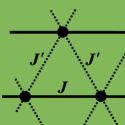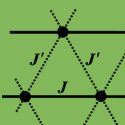Extreme sensitivity
The challenge with modeling a magnetic material is deciding which interactions are most essential. This is the case with Cs2CuCl4, a frustrated quantum magnet consisting of layers of triangularly arranged S=1/2 spins. The strongest exchange coupling is between spins along chains in a layer, while there is a weaker, frustrated bond between the chains. The coupling between layers is an order of magnitude smaller.
Most measurements, including inelastic neutron scattering measurements, are consistent with treating Cs2CuCl4 as a system of weakly coupled chains. However, the low-temperature phase diagram of Cs2CuCl4 is highly sensitive to the direction in which an external magnetic field is applied—meaning there are additional, though very small, anisotropic terms in the Hamiltonian.
Now, writing in Physical Review B, Oleg Starykh from the University of Utah and Hosho Katsura and Leon Balents from the Kavli Institute for Theoretical Physics at the University of California, Santa Barbara present the hierarchy of emergent low-energy scales that control the complex ordering behavior of Cs2CuCl4 in a wide range of magnetic fields oriented in different directions. Using bosonization, renormalization group, and chain mean field theory, they identify a zoo of phases that match well with experiment. In particular, their calculations show that when the magnetic field is lined up with the crystal’s magnetic layers, spins are more correlated with their companions in neighboring triangular layers than with those within the layers, invalidating the naive picture of the system as a layered material. The key message here is that frustration and the quasi- 1D character of the system dramatically amplify the effect of tiny terms in the Hamiltonian to control the ground state. – Sarma Kancharla





